Abstract
In this work the center-crossing condition was integrated in artificial neural networks that incorporate synaptic delays in their connections. These synaptic delay based neural networks act as Central Pattern Generators (CPGs) for walking controllers in hexapod robotic structures. Simulated evolution is used to automatically obtain such neural controllers for walking behaviors. The optimized controllers show the time reasoning capabilities of the synaptic delay based neural networks for the temporal coordination of the hexapod joints. We compared the results against continuous time recurrent neural networks, one of the neural models most used as CPG, when proprioceptive information is used to provide fault tolerance for the required behavior.









Similar content being viewed by others
References
Beer R (1995) On the dynamics of small continuous time recurrent neural networks. Adapt Behav 3(4):469–509
Beer R, Gallagher J (1992) Evolving dynamical neural networks for adaptive behavior. Adapt Behav 22(1):91–122
Buhrmann T, Izquierdo E (2008) Analysis of dynamical recurrent neural networks evolved for two qualitatively different tasks: walking and chemotaxis. In: Bullock S, Noble J, Watson R, Bedau MA (eds) Artificial life XI: proceedings of the eleventh international conference on the simulation and synthesis of living systems. MIT Press, Cambridge, pp 257–264
Campo A, Santos J (2010) Evolution of adaptive center-crossing continuous time recurrent neural networks for biped robot control. In: Proceedings European symposium on artificial neural networks (ESANN 2010), pp 535–540
Chiel HJ, Beer RD, Gallagher JC (1999) Evolution and analysis of model cpgs for walking: I. dynamical modules. J Comput Neurosci 7(2):99–118
Duro RJ, Santos J (1999) Discrete time backpropagation for training synaptic delay based artificial neural networks. IEEE Trans Neural Netw 10(4):779–789
Duro RJ, Santos J (2003) Modeling temporal series through synaptic delay based neural networks. Neural Comput Appl 11:224–237
Feoktistov V (2006) Differential evolution: in search of solutions. Springer, New York
Floreano D, Mondada F (1994) Automatic creation of an autonomous agent: Genetic evolution of a neural-network driven robot. In: Proceedings of the Third international conference on simulation of adaptive behavior: from animals to animats 3 (SAB94), MIT Press, pp 421–430
Floreano D, Mondada F (1998) Evolutionary neurocontrollers for autonomous mobile robots. Neural Netw 11:1461–1478
Funahashi K, Nakamura Y (1993) Approximation of dynamical systems by continuous time recurrent neural networks. Neural Netw 6(6):801–806
Hexapod videos: www.dc.fi.udc.es/ai/~santos/NC_videos/NC_videos.html
Ijspeert AJ (2008) Central pattern generators for locomotion control in animals and robots: a review. Neural Netw 21(4):642–653
Marder E, Bucher D (2001) Central pattern generators and the control of rhythmic movements. Curr Biol 11:R986–R996
Mathayomchan B, Beer R (2002) Center-crossing recurrent neural networks for the evolution of rhythmic behavior. Neural Comput 14:2043–2051
McHale G, Husbands P (2004) Gasnets and other evolvable neural networks applied to bipedal locomotion. In: From animals to animats 8 - Proceedings of the eighth international conference on the simulation of adaptive behavior, pp 163–172
Morse G, Risi S, Snyder CR, Stanley KO (2013) Single-unit pattern generators for quadruped locomotion. In: Proceedings of the genetic and evolutionary computation conference (GECCO 2013). New York, NY: ACM, 719–726
Nolfi S, Floreano D (2000) Evolutionary robotics. MIT press, Cambridge
Price KV, Storn RM, Lampinen JA (2005) Differential evolution. A practical approach to global optimization. Springer, Berlin
Qin AK, Huang VL, Suganthan PN (2009) Differential evolution algorithm with strategy adaptation for global numerical optimization. IEEE Trans Evol Comput 13(2):398–417
Reil T, Husbands P (2002) Evolution of central pattern generators for bipedal walking in a real-time physics environment. IEEE Trans Evol Comput 6(2):159–168
Santos J (2013) Evolved center-crossing recurrent synaptic delay based neural networks for biped locomotion control. In: Proceedings IEEE congress on evolutionary computation (IEEE-CEC 2013), pp 142–148
Santos J, Campo A (2012) Biped locomotion control with evolved adaptive center-crossing continuous time recurrent neural networks. Neurocomputing 86:86–96
Santos J, Duro RJ (2001) Influence of noise on discrete time backpropagation trained networks. Neurocomputing 41(1–4):67–89
Santos J, Fernández P (2015) Evolution of synaptic delay based neural controllers for implementing central pattern generators in hexapod robotic structures. In: Proceedings international work-conference on the interplay between natural and artificial computation (IWINAC 2015), Lecture notes in computer science 9108, pp 30–40
Smith R (2003) Open dynamics engine. http://opende.sourceforge.net
Xiang K, Guo S, Song Z (2012) An electromyography-driven central pattern generator model for robotic control application. In: Proceedings of the 2012 IEEE international conference on robotics and biomimetics, pp 2050–2055
Yang M, Cai Z, Li C, Guan J (2013) An improved adaptive differential evolution algorithm with population adaptation. In: Proceedings of the genetic and evolutionary computation conference (GECCO 2013). New York: ACM, pp 145–152
Acknowledgments
This work was funded by the Ministry of Economy and Competitiveness of Spain (project TIN2013-40981-R).
Author information
Authors and Affiliations
Corresponding author
Rights and permissions
About this article
Cite this article
Santos, J., Fernández, P. Evolved synaptic delay based neural controllers for walking patterns in hexapod robotic structures. Nat Comput 16, 201–211 (2017). https://doi.org/10.1007/s11047-016-9549-2
Published:
Issue Date:
DOI: https://doi.org/10.1007/s11047-016-9549-2




